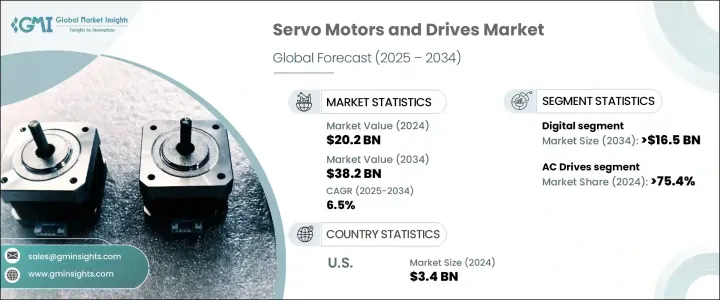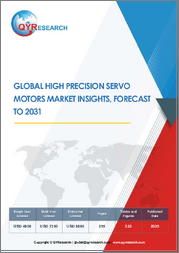
|
시장보고서
상품코드
1741002
서보 모터 및 드라이브 시장 : 시장 기회, 촉진요인, 산업 동향 분석 및 예측(2025-2034년)Servo Motors and Drives Market Opportunity, Growth Drivers, Industry Trend Analysis, and Forecast 2025 - 2034 |
||||||
세계의 서보 모터 및 드라이브 시장 규모는 2024년에 202억 달러로 평가되었고, CAGR 6.5%로 성장할 전망이며, 2034년에는 382억 달러에 이를 것으로 예측되고 있습니다.
산업계가 운용 비용을 삭감하면서 생산성을 향상시키려고 노력하는 가운데, 높은 속도 정밀도 및 위치 정밀도를 제공하는 고도의 모션 컨트롤 시스템의 채용이 점점 중요해지고 있습니다. 특히 산업 자동화 및 스마트 매뉴팩처링에서 연구 개발 투자 증가가, 이러한 성장의 추진에 큰 역할을 하고 있습니다. 기업은 에너지 소비를 줄이고 환경에 미치는 영향을 최소화하는 기술을 우선시하고 있으며, 이 동향은 전 세계적으로 도입된 엄격한 효율화 의무 및 배출 규제에 의해 더욱 뒷받침되고 있습니다. 이러한 변화는 장기적인 시장 확대를 위한 견고한 기반을 만들어 가고 있습니다.

수요가 확대됨에 따라 기존의 장비를 대체하는 보다 스마트하고 비용 효율적인 것으로의 시프트가 현저해지고 있습니다. 서보 모터 및 드라이브 혁신은, 변동하는 조건 하에서 탁월한 정밀도와 일관된 성능을 필요로 하는 최신 제조 및 물류 시스템의 요구에 응하고 있습니다. 게다가 산업계의 디지털화 진전 및 스마트 팩토리 구상의 보급으로 다양한 분야에서 서보 기술의 도입이 가속하고 있습니다. 기업들은 동적 작업 부하에 적응할 수 있고 원격 감시가 가능하며 다른 지능형 서브 시스템과 매끄럽게 통합할 수 있는 시스템을 요구하고 있습니다. 이러한 개발에 의해 경합 환경이 형성되어, 제조업체 각사는 제품의 효율, 정밀도, 유연성을 향상시켜, 관련성을 유지할 필요가 있습니다.
| 시장 범위 | |
|---|---|
| 시작 연도 | 2024년 |
| 예측 연도 | 2025-2034년 |
| 시작 금액 | 202억 달러 |
| 예측 금액 | 382억 달러 |
| CAGR | 6.5% |
시장은 카테고리별로 디지털 유형과 아날로그 유형으로 구분됩니다. 디지털 서보 모터 및 드라이브는 견인차 역할을 하고 있으며, 2034년까지 165억 달러를 넘을 것으로 예측되고 있습니다. 그 인기의 고조는, 기능성 향상, 뛰어난 유지력, 고도의 피드백 및 제어 기능을 제공할 수 있는 것에 기인하고 있습니다. 이러한 시스템은 실시간 모니터링 및 신속한 조정을 필요로 하는 용도에 적합하며 진화하는 자동화 요구에 이상적으로 적합합니다. 디지털 부문은, 자동화된 생산 설비에 대한 투자가 증가해, 다운타임과 유지보수 및 비용의 삭감이 중시되게 되어 있는 것으로부터 이익을 얻고 있습니다.
드라이브의 관점에서 시장은 AC 드라이브와 DC 드라이브로 나뉘어져 있습니다. AC 드라이브는 2024년 전체 시장의 75.4% 이상을 차지하는 큰 점유율을 차지했으며, 2034년까지 안정적인 성장이 예측됩니다. AC 서보 드라이브의 수요는 산업계의 자동화 보급과 인더스트리 4.0 기술의 채용 확대로 급증하고 있습니다. 이러한 드라이브는, 뛰어난 에너지 효율, 고도의 산업용 프로토콜과의 호환성, 다양한 동작 조건에서의 유연성에 의해 지지되고 있습니다. 실시간 데이터 분석 및 예지보전 기능 등 지속적인 기술 향상이 AC 드라이브 솔루션 확대를 더욱 뒷받침하고 있습니다.
미국에서는 서보 모터 및 드라이브 시장이 전년대비 일관된 성장을 보이고 있습니다. 2022년 평가액은 30억 달러였지만 2023년에는 32억 달러로 상승했고, 2024년에는 34억 달러에 달했습니다. 이 나라의 성장 궤도는 산업용 IoT, 스마트 제조 기술의 채택 확대, 완전 자동화 생산 라인의 대두에 의해 뒷받침되고 있습니다. 연구개발에 중점을 두는 연방정부 및 민간 이니셔티브는 산업 환경에서의 AI 통합 지원과 함께 이 분야의 개발을 위한 비옥한 토양을 만들어 내고 있습니다.
시장의 집중도는 여전히 완만하며 상위 5개 기업의 총 점유율은 약 25%입니다. 이러한 대기업은, 제품의 혁신에 투자하고 있을 뿐만 아니라, 산업 자동화 및 에코 시스템 일습을 포함하도록 범위를 넓히고 있습니다. 전략적 파트너십을 형성하고 보완적 기술과의 호환성을 강화함으로써 기존의 드라이브 시스템을 넘어선 포괄적 솔루션을 제공하는 체제를 갖추고 있습니다. 주요 발전에는 서보 시스템으로의 인공지능, 기계학습 알고리즘, IoT 지원 기능의 통합이 있어 자기 제어 및 실시간 최적화가 가능한 스마트 적응형 시스템 개발에 도움을 주고 있습니다.
기술의 진보가 제조의 정세를 끊임없이 변화시키는 가운데, 업계 각사는 실시간 응답성, 보다 높은 효율 레벨, 보다 광범위한 접속성을 지원하는 서보 모터 및 드라이브의 개발에 자원을 쏟고 있습니다. 이러한 발전은 지능형 오토메이션으로의 큰 변화를 반영하며, 다양한 산업 용도에 걸쳐 유연성, 긴 수명 및 확장성을 제공하는 시스템에 대한 요구 증가를 지원합니다.
목차
제1장 조사 방법 및 범위
제2장 주요 요약
제3장 업계 인사이트
- 생태계 분석
- 트럼프 정권의 관세 분석
- 무역에 미치는 영향
- 무역량의 혼란
- 보복조치
- 업계에 미치는 영향
- 공급측의 영향(원재료)
- 주요 원재료의 가격 변동
- 공급망 재구성
- 생산 비용에 미치는 영향
- 수요측의 영향(판매가격)
- 최종 시장에 대한 가격 전달
- 시장 점유율 동향
- 소비자의 반응 패턴
- 공급측의 영향(원재료)
- 영향을 받는 주요 기업
- 전략적인 업계 대응
- 공급망 재구성
- 가격 설정 및 제품 전략
- 정책관여
- 전망 및 향후 검토 사항
- 규제 상황
- 무역에 미치는 영향
- 업계에 미치는 영향요인
- 성장 촉진요인
- 업계의 잠재적 위험 및 과제
- 성장 가능성 분석
- Porter's Five Forces 분석
- PESTEL 분석
제4장 시장 규모 및 예측 : 카테고리별(2021-2034년)
- 주요 동향
- 디지털
- 아날로그
제5장 시장 규모 및 예측 : 드라이브별(2021-2034년)
- 주요 동향
- AC 드라이브
- DC 드라이브
제6장 시장 규모 및 예측 : 용도별(2021-2034년)
- 주요 동향
- 석유 및 가스
- 금속 절단 및 성형
- 자재관리 기기
- 포장 및 라벨링 기계
- 로봇 공학
- 의료 로봇
- 고무 및 플라스틱 기계
- 창고
- 자동화
- 극한 환경 용도
- 반도체 제조 장치
- 무인 반송차
- 일렉트로닉스
- 기타
제7장 시장 규모 및 예측 : 지역별(2021-2034년)
- 주요 동향
- 북미
- 미국
- 캐나다
- 멕시코
- 유럽
- 영국
- 독일
- 프랑스
- 이탈리아
- 스페인
- 노르웨이
- 스웨덴
- 덴마크
- 아시아태평양
- 중국
- 일본
- 인도
- 호주
- 한국
- 태국
- 말레이시아
- 필리핀
- 인도네시아
- 중동 및 아프리카
- 사우디아라비아
- 아랍에미리트(UAE)
- 카타르
- 남아프리카
- 나이지리아
- 이집트
- 알제리
- 라틴아메리카
- 브라질
- 아르헨티나
- 칠레
제8장 기업 프로파일
- ABB
- Advanced Motion Controls
- Allied Motion
- Baumueller
- Bosch Rexroth
- Danfoss
- Delta Electronics
- Fuji Electric
- Hitachi
- Ingenia Cat
- KEB Automation
- Kollmorgen
- Mitsubishi Electric
- Nidec
- Panasonic
- Rockwell Automation
- Schneider Electric
- Siemens
- Yaskawa Electric
The Global Servo Motors and Drives Market was valued at USD 20.2 billion in 2024 and is estimated to grow at a CAGR of 6.5% to reach USD 38.2 billion by 2034, fueled by the rising integration of automation, robotics, and energy-efficient technologies in industrial settings. The adoption of advanced motion control systems that offer high precision in speed and positional accuracy is becoming more critical as industries strive to enhance productivity while cutting operational costs. Increasing investment in research and development, especially in industrial automation and smart manufacturing, is playing a major role in driving this growth. Businesses are prioritizing technologies that reduce energy consumption and minimize environmental impact, a trend further supported by stringent efficiency mandates and emission control regulations introduced globally. These changes are creating a strong foundation for long-term market expansion.

As demand grows, there is a noticeable shift toward smarter, cost-effective alternatives to traditional equipment. Innovations in servo motors and drives are meeting the needs of modern manufacturing and logistics systems that require exceptional accuracy and consistent performance under variable conditions. Additionally, rising industrial digitization and the proliferation of smart factory initiatives are accelerating the deployment of servo technologies across multiple sectors. Companies are looking for systems that can adapt to dynamic workloads, offer remote monitoring, and integrate seamlessly with other intelligent subsystems. These developments are shaping a competitive environment where manufacturers are compelled to improve product efficiency, precision, and flexibility to stay relevant.
| Market Scope | |
|---|---|
| Start Year | 2024 |
| Forecast Year | 2025-2034 |
| Start Value | $20.2 Billion |
| Forecast Value | $38.2 Billion |
| CAGR | 6.5% |
The market is segmented based on category into digital and analog types. Digital servo motors and drives are gaining traction and are anticipated to surpass USD 16.5 billion by 2034. Their increasing popularity is attributed to enhanced functionality, better holding power, and the ability to provide advanced feedback and control features. These systems are well-suited for applications that demand real-time monitoring and rapid adjustments, making them an ideal fit for evolving automation needs. The digital segment benefits from increased investment in automated production facilities and a growing emphasis on reducing downtime and maintenance costs.
From the drive perspective, the market is divided into AC and DC drives. AC drives are expected to dominate with a significant share, accounting for over 75.4% of the total market in 2024, and are projected to grow steadily through 2034. The demand for AC servo drives has risen sharply, driven by widespread automation across industries and the growing adoption of Industry 4.0 technologies. These drives are favored due to their superior energy efficiency, compatibility with advanced industrial protocols, and flexibility in various operational conditions. Continued technological upgrades, including real-time data analytics and predictive maintenance capabilities, are further supporting the expansion of AC drive solutions.
In the United States, the servo motors and drives market has shown consistent year-on-year growth. Valued at USD 3 billion in 2022, it climbed to USD 3.2 billion in 2023 and reached USD 3.4 billion in 2024. The country's growth trajectory is underpinned by the increasing adoption of industrial IoT, smart manufacturing technologies, and the rising presence of fully automated production lines. Federal and private initiatives focused on R&D, alongside support for AI integration in industrial environments, are creating fertile ground for the sector's development.
Market concentration remains moderate, with the top five manufacturers holding a combined share of approximately 25%. These leading firms are not only investing in product innovation but are also broadening their scope to include complete industrial automation ecosystems. By forming strategic partnerships and enhancing compatibility with complementary technologies, they are positioning themselves to deliver comprehensive solutions that go beyond traditional drive systems. Key areas of focus include the integration of artificial intelligence, machine learning algorithms, and IoT-enabled features into servo systems, which helps develop smart, adaptive systems capable of self-regulation and real-time optimization.
With technological advancements continuously reshaping the manufacturing landscape, industry players are channeling resources into developing servo motors and drives that support real-time responsiveness, higher efficiency levels, and broader connectivity. These advancements reflect a larger shift toward intelligent automation and support the rising need for systems that offer flexibility, longevity, and scalability across diverse industrial applications.
Table of Contents
Chapter 1 Methodology & Scope
- 1.1 Market definitions
- 1.2 Base estimates & calculations
- 1.3 Forecast calculation
- 1.4 Data sources
- 1.4.1 Primary
- 1.4.2 Secondary
- 1.4.2.1 Paid
- 1.4.2.2 Public
Chapter 2 Executive Summary
- 2.1 Industry synopsis, 2021 - 2034
Chapter 3 Industry Insights
- 3.1 Industry ecosystem analysis
- 3.2 Trump administration tariffs analysis
- 3.2.1 Impact on trade
- 3.2.1.1 Trade volume disruptions
- 3.2.2 Retaliatory measures
- 3.2.3 Impact on the industry
- 3.2.3.1 Supply-side impact (raw materials)
- 3.2.3.1.1 Price volatility in key materials
- 3.2.3.1.2 Supply chain restructuring
- 3.2.3.1.3 Production cost implications
- 3.2.3.2 Demand-side impact (selling price)
- 3.2.3.2.1 Price transmission to end markets
- 3.2.3.2.2 Market share dynamics
- 3.2.3.2.3 Consumer response patterns
- 3.2.3.1 Supply-side impact (raw materials)
- 3.2.4 Key companies impacted
- 3.2.5 Strategic industry responses
- 3.2.5.1 Supply chain reconfiguration
- 3.2.5.2 Pricing and product strategies
- 3.2.5.3 Policy engagement
- 3.2.6 Outlook and future considerations
- 3.2.7 Regulatory landscape
- 3.2.1 Impact on trade
- 3.3 Industry impact forces
- 3.3.1 Growth drivers
- 3.3.2 Industry pitfalls & challenges
- 3.4 Growth potential analysis
- 3.5 Porter's Analysis
- 3.5.1 Bargaining power of suppliers
- 3.5.2 Bargaining power of buyers
- 3.5.3 Threat of new entrants
- 3.5.4 Threat of substitutes
- 3.6 PESTEL Analysis
Chapter 4 Market Size and Forecast, By Category, 2021 - 2034, ('000 Units & USD Million)
- 4.1 Key trends
- 4.2 Digital
- 4.3 Analog
Chapter 5 Market Size and Forecast, By Drive, 2021 - 2034, ('000 Units & USD Million)
- 5.1 Key trends
- 5.2 AC drive
- 5.3 DC drive
Chapter 6 Market Size and Forecast, By Application, 2021 - 2034, ('000 Units & USD Million)
- 6.1 Key trends
- 6.2 Oil and gas
- 6.3 Metal cutting & forming
- 6.4 Material handling equipment
- 6.5 Packaging and labeling machinery
- 6.6 Robotics
- 6.7 Medical robotics
- 6.8 Rubber & plastics machinery
- 6.9 Warehousing
- 6.10 Automation
- 6.11 Extreme environment applications
- 6.12 Semiconductor machinery
- 6.13 AGV
- 6.14 Electronics
- 6.15 Others
Chapter 7 Market Size and Forecast, By Region, 2021 - 2034, ('000 Units & USD Million)
- 7.1 Key trends
- 7.2 North America
- 7.2.1 U.S.
- 7.2.2 Canada
- 7.2.3 Mexico
- 7.3 Europe
- 7.3.1 UK
- 7.3.2 Germany
- 7.3.3 France
- 7.3.4 Italy
- 7.3.5 Spain
- 7.3.6 Norway
- 7.3.7 Sweden
- 7.3.8 Denmark
- 7.4 Asia Pacific
- 7.4.1 China
- 7.4.2 Japan
- 7.4.3 India
- 7.4.4 Australia
- 7.4.5 South Korea
- 7.4.6 Thailand
- 7.4.7 Malaysia
- 7.4.8 Philippines
- 7.4.9 Indonesia
- 7.5 Middle East & Africa
- 7.5.1 Saudi Arabia
- 7.5.2 UAE
- 7.5.3 Qatar
- 7.5.4 South Africa
- 7.5.5 Nigeria
- 7.5.6 Egypt
- 7.5.7 Algeria
- 7.6 Latin America
- 7.6.1 Brazil
- 7.6.2 Argentina
- 7.6.3 Chile
Chapter 8 Company Profiles
- 8.1 ABB
- 8.2 Advanced Motion Controls
- 8.3 Allied Motion
- 8.4 Baumueller
- 8.5 Bosch Rexroth
- 8.6 Danfoss
- 8.7 Delta Electronics
- 8.8 Fuji Electric
- 8.9 Hitachi
- 8.10 Ingenia Cat
- 8.11 KEB Automation
- 8.12 Kollmorgen
- 8.13 Mitsubishi Electric
- 8.14 Nidec
- 8.15 Panasonic
- 8.16 Rockwell Automation
- 8.17 Schneider Electric
- 8.18 Siemens
- 8.19 Yaskawa Electric



















